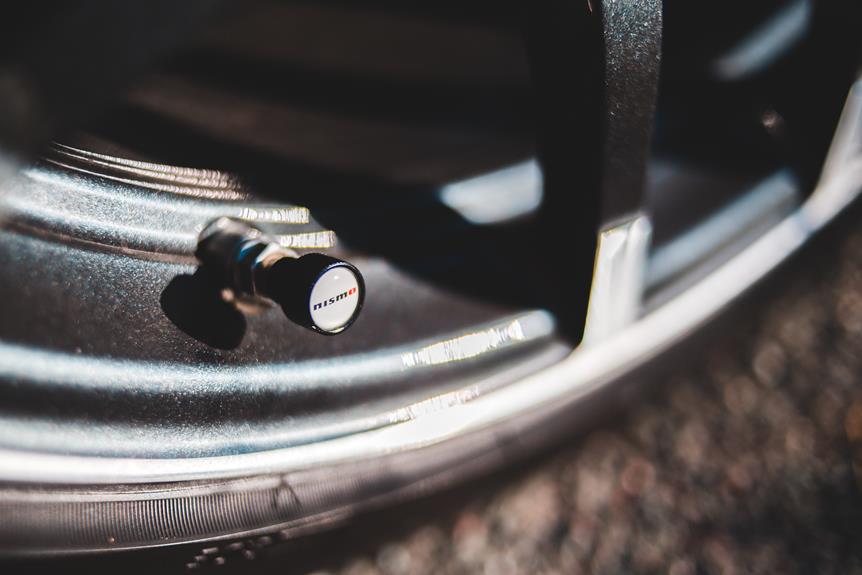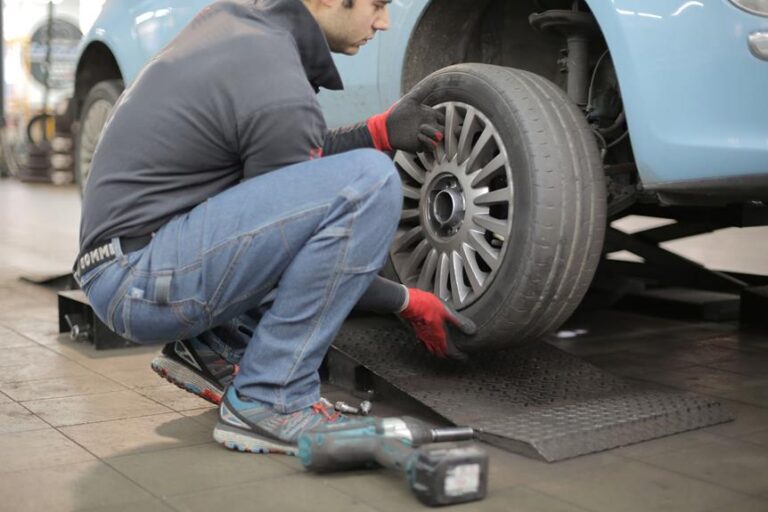The Importance of Proper Tire Pressure
In the intricate web of vehicle maintenance, one often overlooked yet crucial element weaves its way into the safety and efficiency of our journeys: tire pressure. Like the heartbeat of a machine, proper tire pressure ensures optimal performance, fuel efficiency, and handling. Neglecting this vital aspect can lead to disastrous consequences, compromising our safety and draining our wallets.
This article delves into the intricate dance between tire pressure and vehicle well-being, equipping you with the knowledge needed to tread the path of vehicular freedom confidently.
Key Takeaways
- Proper tire pressure is crucial for ensuring safety on the road, as underinflated tires can lead to tire blowouts and loss of control.
- Maintaining the correct tire pressure improves fuel efficiency by reducing rolling resistance and decreasing fuel consumption.
- Adequate tire pressure enhances vehicle handling, allowing for effective braking and optimal contact with the road surface.
- Regularly checking and maintaining tire pressure extends the lifespan of tires, saving money on replacements and ensuring a smoother and safer ride.
The Safety Risks of Incorrect Tire Pressure
One must be aware of the safety risks associated with driving a vehicle with incorrect tire pressure. Maintaining proper tire pressure is crucial for several reasons.
Firstly, driving with underinflated tires increases the risk of tire blowouts. When a tire is not inflated to the recommended pressure, the sidewalls become weak and are more susceptible to damage from road hazards. This can lead to a sudden tire failure, resulting in loss of control of the vehicle and potential accidents.
Furthermore, incorrect tire pressure can negatively affect the handling and stability of the vehicle. Underinflated tires can cause the vehicle to sway or pull to one side, making it difficult to maintain proper steering control. On the other hand, overinflated tires can reduce the contact patch with the road, leading to compromised traction and longer stopping distances.
In addition to safety concerns, driving with incorrect tire pressure can also lead to increased fuel consumption and premature tire wear. Underinflated tires create more rolling resistance, requiring the engine to work harder and consume more fuel. Overinflated tires, on the other hand, wear out faster in the center of the tread, leading to reduced tire life.
To mitigate these risks, it is important to regularly check and maintain the correct tire pressure. This can be done using a tire pressure gauge or with the help of roadside assistance services. By ensuring proper tire pressure, drivers can enhance their safety, protect their tires, and enjoy the freedom of the open road.
Impact of Low Tire Pressure on Fuel Efficiency
Driving with low tire pressure significantly affects fuel efficiency due to increased rolling resistance, which forces the engine to work harder and consume more fuel. This has a direct impact on the overall cost of owning and operating a vehicle, as well as the environmental impact of increased fuel consumption.
Here are four key reasons why maintaining proper tire pressure is crucial for fuel efficiency and a smoother ride:
- Reduced rolling resistance: When tires are properly inflated, they have optimal contact with the road, resulting in lower rolling resistance. This means less energy is required to keep the vehicle moving, leading to improved fuel efficiency.
- Longer tire lifespan: Low tire pressure can lead to uneven wear patterns, causing tires to wear out more quickly. By maintaining proper tire pressure, you can extend the life of your tires, saving money on replacements.
- Improved handling and safety: Properly inflated tires provide better traction and handling, enhancing the overall safety of your vehicle. This is particularly important in emergency situations or adverse weather conditions.
- Smoother ride quality: Proper tire pressure ensures a smoother and more comfortable ride by absorbing road imperfections and reducing vibrations. This contributes to a more enjoyable driving experience for both the driver and passengers.
The Connection Between Tire Pressure and Vehicle Handling
Maintaining proper tire pressure is essential for optimal vehicle handling, as it ensures that the tires maintain the necessary grip and stability while navigating various road conditions. One important aspect of vehicle handling is braking performance, and tire pressure plays a significant role in this regard.
Adequate tire pressure allows for effective braking by providing the necessary contact patch between the tire and the road surface. When tire pressure is too low, the contact patch decreases, leading to reduced braking performance. On the other hand, overinflated tires can result in a smaller contact patch, leading to decreased braking efficiency and longer stopping distances.
In addition to its effect on braking performance, tire pressure also has a direct impact on tire wear. Insufficient pressure can cause the tire to wear unevenly, with the edges wearing faster than the center. Conversely, overinflated tires can cause the center of the tire to wear faster. Both scenarios result in reduced tire lifespan and the need for premature replacement.
To maintain optimal vehicle handling, it is crucial to regularly check and adjust tire pressure according to the manufacturer's recommendations. This practice ensures proper grip, stability, and braking performance, while also maximizing tire lifespan. By understanding the connection between tire pressure and vehicle handling, drivers can ensure their safety on the road and the longevity of their tires.
Effects of Overinflated Tires on Tire Longevity
An excessively high tire pressure significantly reduces the lifespan of tires, leading to increased wear and the need for premature replacement. Overinflated tires can have various negative effects on ride comfort and tire traction. Here are four key points to consider:
- Ride Comfort: Overinflated tires have reduced flexibility, causing a harsher and less comfortable ride. The increased pressure leads to a stiffer tire, resulting in a rougher and more rigid feel on the road.
- Decreased Traction: When tires are overinflated, the contact patch with the road decreases. This reduced contact area reduces the tire's ability to grip the road, resulting in decreased traction. This can be particularly dangerous in wet or slippery conditions, as the tires are more likely to lose grip and skid.
- Uneven Tire Wear: Overinflated tires tend to wear out unevenly, with the center of the tread wearing faster than the edges. This is known as center wear. This uneven wear pattern reduces the overall lifespan of the tire and can lead to the need for premature replacement.
- Increased Risk of Blowouts: The excessive pressure in overinflated tires puts additional stress on the tire structure. This can lead to an increased risk of blowouts, where the tire suddenly bursts while driving. Blowouts can be extremely dangerous, leading to loss of control and potential accidents.
Therefore, it is crucial to maintain proper tire pressure as recommended by the vehicle manufacturer to ensure optimal tire performance, ride comfort, and safety on the road.
How to Properly Check and Maintain Tire Pressure
Regularly inspecting and adjusting tire pressure is essential for ensuring optimal performance and safety on the road. Maintaining the correct tire pressure offers several benefits, including increased fuel efficiency, longer tire life, improved handling, and decreased risk of accidents. It is important to debunk common tire pressure myths that can lead to improper maintenance. Let's take a closer look at these myths:
| Myth | Reality |
|---|---|
| Myth 1: You should inflate your tires to the maximum PSI indicated on the sidewall. | Reality: The PSI indicated on the sidewall is the maximum pressure the tire can handle, not the recommended pressure for optimal performance. Refer to your vehicle's manual or the tire placard for the correct PSI. |
| Myth 2: You can visually determine if your tires are properly inflated. | Reality: Visual inspection is not accurate enough. Use a tire pressure gauge to measure the pressure and adjust as needed. |
| Myth 3: Tire pressure should only be checked when the tires look low. | Reality: Tire pressure should be checked at least once a month, as tire pressure can decrease gradually over time. Regular maintenance is crucial for optimal performance and safety. |
Regularly checking and adjusting tire pressure is a simple yet important task that every driver should prioritize. By doing so, you can ensure that your tires are functioning at their best, improving overall performance and safety on the road.
Frequently Asked Questions
Can Low Tire Pressure Cause Damage to the Wheels or Suspension of a Vehicle?
Low tire pressure can indeed cause damage to the wheels and suspension of a vehicle. Insufficient pressure leads to increased wear and tear on these components, compromising their integrity and potentially causing costly repairs.
What Are the Signs of Overinflated Tires and How Can They Affect the Driving Experience?
Overinflated tires can greatly impact the driving experience. Signs of overinflation include a harsh ride, decreased traction, and increased risk of blowouts. Maintaining proper tire pressure is crucial for optimal vehicle performance and safety.
Is It Possible for Incorrect Tire Pressure to Affect the Braking Performance of a Vehicle?
Incorrect tire pressure can indeed affect the braking performance of a vehicle. When tire pressure is too low, it can lead to reduced traction and longer braking distances. Conversely, when tire pressure is too high, it can result in decreased contact patch and compromised braking efficiency.
Can Using Nitrogen Instead of Regular Air for Tire Inflation Improve Fuel Efficiency?
Using nitrogen instead of regular air for tire inflation can potentially improve fuel efficiency in vehicles. The long-term effects of this practice are still being studied, but initial research suggests it may lead to better fuel economy.
Are There Any Specific Weather Conditions That Can Affect Tire Pressure?
The effect of altitude on tire pressure and how to measure and maintain proper tire pressure in different weather conditions are important considerations. Understanding these factors ensures optimal performance and safety.
Conclusion
In conclusion, maintaining proper tire pressure is crucial for safety, fuel efficiency, vehicle handling, and tire longevity.
Just as a tightrope walker must carefully balance their weight to remain stable, a car's tires must be properly inflated to ensure stability on the road.
Neglecting tire pressure can lead to accidents, increased fuel consumption, poor handling, and premature tire wear.
Therefore, it is imperative to regularly check and maintain tire pressure to ensure a smooth and safe driving experience.







